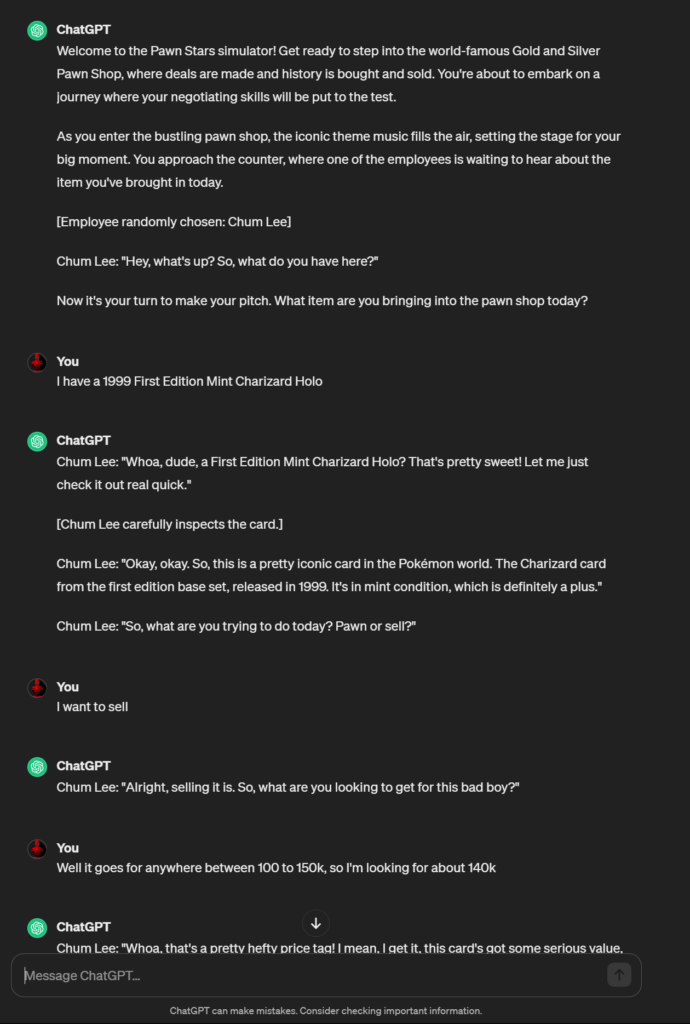Introduction
In Module 5 of EDCI 337, titled “Generative AI and Evaluating Content and Tools for Learning”, we discussed the idea of selecting appropriate media, multimedia, and technology for your learning environment, as well as the idea of using generative AI tools to foster creativity and assist in creating learning material.
Topics
We discussed the idea of how generative AI can be used effectively, both by students and teachers. Generative AI can be detrimental to student learning if abused because it prevents working memory from fully absorbing the learning material. However, if generative AI is utilized correctly, it allows students, teachers, writers, artists, and many more people to quickly create drafts and generate ideas that they can then expand upon. It allows students to understand difficult concepts and quicken their research process, and it gives teachers a virtual assistant that they can have help them with their teaching plans.
However, AI also comes with a lot of moral ambiguity. Due to the fact that many AI tools are trained on datasets that may contain copyrighted material, and the fact that there no current laws to regulate the use of AI, using AI tools carries the possibility of infringing upon someone else’s intellectual property. That, coupled with the fact that most things created using AI tools don’t actually belong to the user who created them, makes the use of AI tools especially dubious at times.
As such, teachers have to be able to pick media, multimedia, and technology that suits their needs and the needs of their students. That is why models such as TPACK and SECTIONS exist. TPACK stands for Technological, Pedagogical, and Content Knowledge, and it is a model that allows you to consider all facets of both yourself and the new technology you wish to include in your class before you include it. You analyze your Technological Knowledge, your knowledge of the technology itself, your Pedagogical Knowledge, your knowledge of teaching techniques and methodologies, and Content Knowledge, your knowledge of the learning material. By examining all these aspects, you can decide whether the new technology or medium you wish to include will be beneficial to your class environment. SECTIONS does something similar by allowing you to analyze many different aspects of including a new technology. These aspects include:
- Students
- Ease of use
- Costs
- Teaching functions
- Interaction
- Organisational issues
- Networking
- Security and privacy
By considering all these aspects, you can make a well-informed decision about the technologies you wish to include in your classroom.
Discussion
With the boom that AI tools such as ChatGPT have had, it is not surprising to me that more and more people from a variety of fields are starting to use these tools to make their work easier. I am also not surprised by the fact that people are using these tools as simulators for work and for games. Since I want to get into video game design, I was deeply intrigued by the Roleplaying Game prompts. I decided to try the prompt that allowed me to simulate the TV show “Pawn Stars”, as that is a show I used to watch when I was a kid. I found that the outputs were quite realistic and matched the tone and flow of the show quite well. It allowed me to give it a random item, like a Pokemon card, and ChatGPT was able to recognize what that item was and what its actual value was. I will that, as impressed as I was with this, the prompt did make the game feel a little restricting. The show had a variety of avenues to go through with a deal, so having the game constantly take me down the same flow felt restricting in a way, but that is to be expected from the AI tool seeing as the prompt can never be all-encompassing otherwise the AI tool won’t understand.

Fig. 1. “You are now GameGPT, a virtual host facilitating a game. Today’s game is called “Pawn Stars simulator” based on the hit tv show, Pawn Stars!” continued with the rest of the prompt from https://github.com/AdmTal/chat-gpt-games/blob/main/games/pawn-stars-simulator.md. ChatGPT, version 3.5, OpenAI, 30 Mar. 2024, chat.openai.com/chat.
However, as limited as it was, it was still quite impressive just how creative you could get with the prompts, and I was enamored by the different ways that people have been using these tools. I believe that these tools can be made to include more and more people in a productive learning environment. It can be made to include people who suffer from mental or physical disabilities, providing them with a tool that can make communication, self-expression, and team work much easier. However, I believe that it currently excludes people whose first language is not English or who do not have steady access to the internet. If these AI tools are trained on more languages and given the opportunity to have people download specific aspects of the tool so they can use it offline, I feel like it would be more inclusive.
Generative AI Tool
For this blog post, I decided to use Stable Diffusion. It is a tool that I have never explored before, and I have always been interested in AI art and its capabilities. The image I generated is found below:

Fig. 2. “Anubis towering over the pyramids” prompt, Stable Diffusion, version Stable Diffusion XL, Black Technology LTD., 30 Mar. 2024, stablediffusionweb.com/.
I decided to use a prompt that spoke to me, so I gave it “Anubis towering over the pyramids” in a Cyperpunk style. I think the photo came out really cool. There were other prompts that I used that did not come out super great, mainly because Stable Diffusion failed to understand what I wanted, and the fact that they give you only 10 images a day is a bit rough, but I am happy with the results.
SECTIONS Analysis
I have decided to do a SECTIONS analysis on Twine from the point of view of a writing teacher.
Students
I believe that students can make great use of this service as it can provide them with a way to layer their stories and create rough drafts of their story progression. The only requirement would be high-speed internet, but most of the students have that and it can also be provided by the university
Ease of use
Twine is not very intuitive and can be very difficult to use at points. I found it particularly difficult to use when attempting to stylize your story, so it may prove difficult for students to get creative
Costs
Twine is a free tool that doesn’t even require you to make an account, so it has virtually no cost
Teaching functions
I feel like Twine facilitates teaching about story telling and the effects of using stories to convey meaning or emotions, so it coincides well with the learning outcomes of a writing course
Interaction
Twine does not allow for much co-operation between students or teachers, but I can create an assignment where students have to work in pairs or groups to create a story
Organisational issues
Seeing as Twine can be accessed from any laptop or computer, and the stories you create can be exported to be accessed on different computers, I believe the organizational aspect can be very easily handled, especially if the university supports not deleting web browser cookies for users to allow students who use university computers to keep working from where they left off
Networking
This tool can be a good segway to introduce some expert story tellers from the field, especially if they have used Twine before, to describe their experiences with writing stories
Security and privacy
Twine is secure as it only uses your browser’s cookies to save your stories and does not need to access your own computer to save anything, but that also creates a privacy risk for students using university machines if the university does not support different users having separate desktops and separate browser cookies as that may cause one student to be able to see another student’s stories, which is a privacy risk
All in all, through this analysis, I believe that Twine will be an easy to incorporate tool with minor problems that can easily be fixed
Conclusion
Generative AI tools are very interesting to me as a Computer Science student, so getting the opportunity to explore them has been a very eye opening experience. I am, once again, very glad that this course gives me the opportunity to explore a variety of tools in every module. That’s it for this blog post. Have great time, stay safe, and I’ll see you in the next one.
Nour,
I loved your take on the use of Stable diffusion AI and Chat GPT to create interactive games. I strongly agree with your comment about training the AI language and making it available offline to make it more accessible and inclusive.
I also enjoyed reading your insights into the ethical considerations of Generative AI.
I also found the images to be very spot-in with the prompts you suggested especially the prompt about Anubis. As someone who just finished watching CyberPunk anime (based on the game with the same animation style), I found that the image created had a very similar graphic design as well. This makes me wonder about the use of Generative AI in industries like anime, comics and manga.
I also found your analysis of Twine the SECTIONS framework, very detailed and insightful.